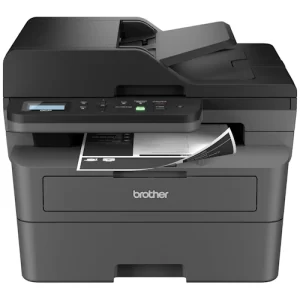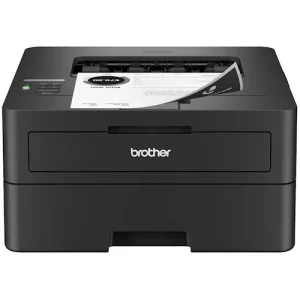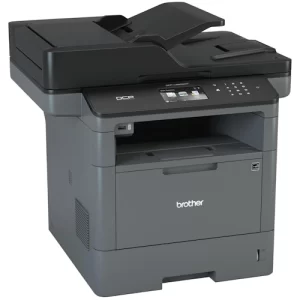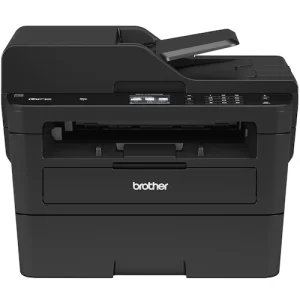Laser Printers
-
Brother Wireless DCP-L2640DW Compact Monochrome Multi-Function Laser Printer
- Print and copy up to 36ppm‡
- 50-page capacity auto document feeder‡
- Ethernet and dual band wireless networking
₹18,738.00 -
Brother HL-L2460DW Wireless Compact Monochrome Laser Printer
- Print up to 36ppm
- Automatic duplex (2-sided) printing
- Ethernet and dual band wireless networking
₹14,936.00 -
Brother Printer MFCL8610CDW Business Color Laser All-in-One
- Print and copy up to 33 pages per minute‡
- Cost efficient color output
- 50-page capacity auto document feeder
₹53,738.00 -
Brother Monochrome Laser Printer, Multifunction Printer and Copier
- Up to 42 pages per minute
- Duplex 2 sided print
- Ethernet – 10/100 Base-TX
- 8000 pages Inbox Toner
₹36,588.00 -
Brother Monochrome Laser Printer All-in-One MFCL2710DW
- Print up to 32 pages per minute‡
- Automatic duplex (2-sided) printing
- 250-sheet capacity paper tray
₹22,188.00
Laser Printers: The Ultimate Printing Solution for Home and Office
Introduction to Laser Printers
In an age where efficiency and quality are paramount, laser printers have emerged as a go-to choice for both home and office environments. Renowned for their speed, precision, and cost-effectiveness, laser printers are ideal for anyone from students to large corporations. This comprehensive guide will delve into the features, benefits, applications, and maintenance of laser printers, along with an extensive FAQ section to answer common questions.
What is a Laser Printer?
A laser printer is a type of printer that uses a laser beam to produce high-quality text and images on paper. The technology behind laser printing involves transferring toner (a fine powder) onto paper through a series of precise processes. Unlike inkjet printers that spray ink, laser printers fuse toner onto the paper, resulting in sharp, professional-looking prints.
Key Components of a Laser Printer
- Laser Scanner: This component generates a laser beam that scans back and forth across a rotating drum, creating a latent image of the document to be printed.
- Drum Unit: The drum is charged with static electricity and receives the laser beam’s pattern. It attracts toner particles to form the desired image.
- Toner Cartridge: Contains the powdered toner that is transferred to the drum and subsequently fused to the paper. Toner cartridges are generally more efficient and longer-lasting than ink cartridges.
- Fuser Unit: This heats the toner and fuses it onto the paper, ensuring that the print is durable and resistant to smudging.
- Control Panel: A user interface that allows you to configure printer settings, monitor status, and troubleshoot any issues.
Benefits of Using Laser Printers
1. High-Speed Printing
One of the most significant advantages of laser printers is their speed. They can produce documents much faster than inkjet printers, making them ideal for busy environments that require high-volume printing.
2. Cost-Effective for High Volumes
While the initial cost of a laser printer may be higher than that of an inkjet printer, the cost per page is significantly lower. This is particularly beneficial for businesses that need to print large volumes of documents.
3. Superior Print Quality
Laser printers produce sharp text and high-quality images, making them suitable for professional documents, marketing materials, and presentations. The resolution is generally superior compared to inkjet printers.
4. Durability of Prints
Since laser printers fuse toner onto the paper, the prints are more durable and resistant to fading, smudging, and water damage. This is especially advantageous for documents that need to withstand the test of time.
5. Low Maintenance
Laser printers require less maintenance than inkjet printers. Toner cartridges last longer, and the printer itself typically has fewer moving parts, resulting in lower overall maintenance costs.
6. Eco-Friendly Options
Many modern laser printers are designed with energy efficiency in mind and use less power during operation. Additionally, toner cartridges can often be recycled, reducing environmental impact.
Applications of Laser Printers
Laser printers are versatile and can be used in various settings:
1. Home Use
For home users, laser printers are perfect for printing documents, school assignments, and high-quality photos. They provide a reliable solution for everyday printing needs without the hassle of constantly replacing ink cartridges.
2. Small and Medium-Sized Businesses (SMBs)
SMBs benefit from the speed and efficiency of laser printers. They can produce marketing materials, invoices, and reports quickly, helping businesses maintain productivity and professionalism.
3. Large Corporations
In larger organizations, laser printers can handle high-volume printing tasks and are often used for printing contracts, legal documents, and other essential paperwork.
4. Educational Institutions
Schools and universities rely on laser printers for printing educational materials, student assignments, and administrative documents. The speed and cost-effectiveness make them ideal for academic settings.
5. Creative Professionals
Graphic designers and marketing professionals use laser printers for producing high-quality proofs and presentations. The superior print quality ensures that their work looks polished and professional.
Choosing the Right Laser Printer
When selecting a laser printer, consider the following factors:
1. Print Volume
Determine your monthly print volume to find a printer that can meet your needs. Some printers are designed for light usage, while others are built for heavy-duty tasks.
2. Print Quality
Consider the print resolution (measured in DPI, or dots per inch) to ensure the printer meets your quality standards. A higher DPI is better for producing sharp images and detailed text.
3. Connectivity Options
Look for printers with various connectivity options, such as USB, Ethernet, and Wi-Fi. This allows for flexible printing solutions, including mobile printing from smartphones and tablets.
4. Size and Design
Evaluate the space available in your home or office. Compact models are ideal for small spaces, while larger printers may offer additional features and higher print volumes.
5. Additional Features
Consider features like duplex printing (automatic double-sided printing), scanning and copying capabilities, and touchscreen interfaces for easier operation.
6. Cost of Consumables
Research the cost of toner cartridges and other consumables. Some printers have lower initial prices but may have high ongoing costs for toner replacement.
Maintenance Tips for Laser Printers
To keep your laser printer in optimal condition, follow these maintenance tips:
1. Regularly Clean the Printer
Dust and debris can accumulate inside the printer, affecting print quality. Regularly clean the exterior and interior components, including the drum and toner areas.
2. Replace Toner Cartridges on Time
Monitor toner levels and replace cartridges when they run low to avoid print quality issues. Use OEM (Original Equipment Manufacturer) toner for the best results.
3. Check and Replace the Drum Unit
The drum unit has a limited lifespan and may need to be replaced periodically. Follow the manufacturer’s guidelines for replacement timing.
4. Update Drivers and Firmware
Regularly check for updates to your printer’s drivers and firmware to ensure compatibility and access to new features.
5. Perform Test Prints
Occasionally run test prints to check print quality and ensure that the printer is functioning correctly. Address any issues promptly to avoid further problems.
6. Store Toner Properly
Keep toner cartridges in a cool, dry place, and avoid exposing them to direct sunlight or extreme temperatures to maintain their quality.
FAQ About Laser Printers
1. What is the difference between a laser printer and an inkjet printer?
Laser printers use toner and a laser beam to produce high-quality prints, while inkjet printers use liquid ink. Laser printers are generally faster, more cost-effective for high-volume printing, and produce sharper text, while inkjet printers are better for photos and color graphics.
2. Are laser printers expensive to operate?
While laser printers have a higher upfront cost, they are generally more cost-effective for high-volume printing due to the lower cost per page of toner compared to ink cartridges.
3. Can laser printers print in color?
Yes, there are color laser printers available that can produce vibrant color prints. They use multiple toner cartridges for cyan, magenta, yellow, and black (CMYK) to create a full range of colors.
4. Do laser printers require special paper?
Most laser printers can use standard printer paper, but using paper specifically designed for laser printers can enhance print quality and prevent issues such as paper jams.
5. How often do I need to replace the toner cartridge?
The frequency of toner replacement depends on your print volume and the specific printer model. Generally, a toner cartridge can last from a few hundred to several thousand pages.
6. Can I use third-party toner cartridges?
While third-party toner cartridges can save money, they may not provide the same quality or reliability as OEM cartridges. Using third-party toner may also void the printer’s warranty.
7. What should I do if my laser printer is jammed?
Consult the printer’s user manual for troubleshooting steps. Typically, you’ll need to remove any stuck paper and check for any remaining scraps in the feed area.
8. Is it necessary to let my printer rest?
Laser printers do not require extensive resting periods, but if they are not used for an extended time, it’s advisable to run a test print occasionally to keep the components functioning properly.
9. How can I connect my laser printer to a Wi-Fi network?
Most modern laser printers come with Wi-Fi connectivity options. You can connect the printer to your network using the printer’s control panel and follow the setup instructions provided in the user manual.
10. Are there eco-friendly laser printers available?
Yes, many manufacturers produce eco-friendly laser printers designed to consume less energy and produce less waste. Look for models with Energy Star certification or similar eco-labels.
Conclusion
Laser printers are a powerful solution for all your printing needs, whether for home, business, or creative projects. Their speed, efficiency, and superior print quality make them an invaluable tool in today’s fast-paced world. By understanding their features, benefits, and maintenance requirements, you can make an informed decision when selecting the right laser printer for your needs.
Investing in a high-quality laser printer will not only enhance your productivity but also ensure that your documents and images are printed with the utmost precision and clarity. Explore our extensive range of laser printers today and discover the perfect model to meet your printing demands!





